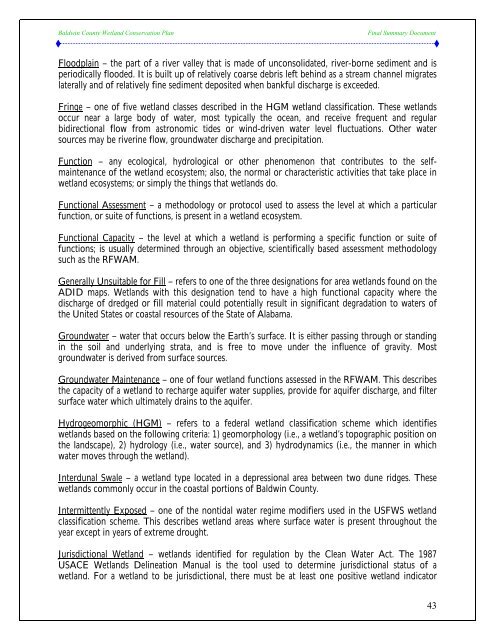Baldwin County Wetland Conservation Plan - Alabama Department ...
Baldwin County Wetland Conservation Plan - Alabama Department ...
Baldwin County Wetland Conservation Plan - Alabama Department ...
You also want an ePaper? Increase the reach of your titles
YUMPU automatically turns print PDFs into web optimized ePapers that Google loves.
<strong>Baldwin</strong> <strong>County</strong> <strong>Wetland</strong> <strong>Conservation</strong> <strong>Plan</strong> Final Summary Document<br />
Floodplain – the part of a river valley that is made of unconsolidated, river-borne sediment and is<br />
periodically flooded. It is built up of relatively coarse debris left behind as a stream channel migrates<br />
laterally and of relatively fine sediment deposited when bankful discharge is exceeded.<br />
Fringe – one of five wetland classes described in the HGM wetland classification. These wetlands<br />
occur near a large body of water, most typically the ocean, and receive frequent and regular<br />
bidirectional flow from astronomic tides or wind-driven water level fluctuations. Other water<br />
sources may be riverine flow, groundwater discharge and precipitation.<br />
Function – any ecological, hydrological or other phenomenon that contributes to the selfmaintenance<br />
of the wetland ecosystem; also, the normal or characteristic activities that take place in<br />
wetland ecosystems; or simply the things that wetlands do.<br />
Functional Assessment – a methodology or protocol used to assess the level at which a particular<br />
function, or suite of functions, is present in a wetland ecosystem.<br />
Functional Capacity – the level at which a wetland is performing a specific function or suite of<br />
functions; is usually determined through an objective, scientifically based assessment methodology<br />
such as the RFWAM.<br />
Generally Unsuitable for Fill – refers to one of the three designations for area wetlands found on the<br />
ADID maps. <strong>Wetland</strong>s with this designation tend to have a high functional capacity where the<br />
discharge of dredged or fill material could potentially result in significant degradation to waters of<br />
the United States or coastal resources of the State of <strong>Alabama</strong>.<br />
Groundwater – water that occurs below the Earth’s surface. It is either passing through or standing<br />
in the soil and underlying strata, and is free to move under the influence of gravity. Most<br />
groundwater is derived from surface sources.<br />
Groundwater Maintenance – one of four wetland functions assessed in the RFWAM. This describes<br />
the capacity of a wetland to recharge aquifer water supplies, provide for aquifer discharge, and filter<br />
surface water which ultimately drains to the aquifer.<br />
Hydrogeomorphic (HGM) – refers to a federal wetland classification scheme which identifies<br />
wetlands based on the following criteria: 1) geomorphology (i.e., a wetland’s topographic position on<br />
the landscape), 2) hydrology (i.e., water source), and 3) hydrodynamics (i.e., the manner in which<br />
water moves through the wetland).<br />
Interdunal Swale – a wetland type located in a depressional area between two dune ridges. These<br />
wetlands commonly occur in the coastal portions of <strong>Baldwin</strong> <strong>County</strong>.<br />
Intermittently Exposed – one of the nontidal water regime modifiers used in the USFWS wetland<br />
classification scheme. This describes wetland areas where surface water is present throughout the<br />
year except in years of extreme drought.<br />
Jurisdictional <strong>Wetland</strong> – wetlands identified for regulation by the Clean Water Act. The 1987<br />
USACE <strong>Wetland</strong>s Delineation Manual is the tool used to determine jurisdictional status of a<br />
wetland. For a wetland to be jurisdictional, there must be at least one positive wetland indicator<br />
43

















